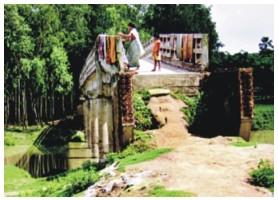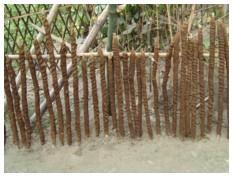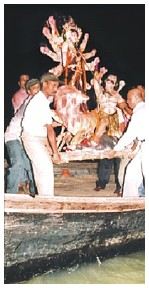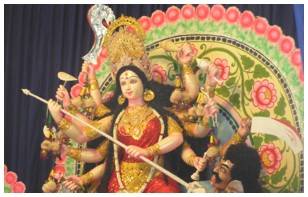|
|
|
|
|
|
|
|
|
|
|
|
|
|
|
|
|
|
|
|
|
|
|
|
|
|
| |
WORLDCOOK'S TRAVELS - Daily life in Bangladesh (2) |
|
|
|
Recipes from Bangladesh |
|
Travel to Bangladesh |
|
Travel to other countries |
| On Eid-ul-Azha, all Muslims in Bangladesh must slaughter an animal, and the streets of Dhaka are red with blood. On those days, I prefer to stay home after breakfast. |
|
|
|
But
normally, the streets of
Dhaka are a major source of inspiration.
In the morning, they look quite different, possibly because I already
leave the house around seven, when the city is not completely awake yet.
It is still quiet in the streets, apart from the weird expat who is on the
way to work in a car. But you can also suddenly see a young boy, clenching
in his hands the ends of 12 ropes, with which he is walking his goats.
Their black and white legs are entangled and they move nervously to stay
away as far as they can from motorized traffic. Close to the garment
factories, you see the long rows of colorful saris of the young women,
walking in long rows between the dirty dark buildings, on the way the work.
Long rows are also waiting for the embassies, but these are men, without
exception. They are waiting for the doors to open, to request a visa,
often in vain. If you are unlucky, in the evening you still have not
entered the building. That is why anybody with a little spending power
will hire a “stand-in”, who gives them a call when they are almost at the
counter. |
In the evening, when I go home,
the streets of Dhaka look completely different. There are millions of
cars, one giant traffic jam from office to home. Cars are honking and
rickshaws are ringing their bells, in a futile effort to bring a bit of
movement into these commuters. Nobody can go anywhere and therefore, no
movement takes place. Totally different things are on sale now. Boys run
between the cars with bottles of water, books and bags of popcorn; on the si de
of the road, somebody is selling car bumpers. The big lights, illuminating
the huge billboards, attract extra attention to advertisements for things
the average Bangladeshi cannot afford: travels abroad, camera’s, diamonds.
The meters high LCD-television on Gulshan 2 circle is showing more modest
goods, like spices and rice. As it takes at least 15 minutes to pass the
traffic light there, even looking at the Indian woman who with a broad
smile is praising her meal is a welcome entertainment. de
of the road, somebody is selling car bumpers. The big lights, illuminating
the huge billboards, attract extra attention to advertisements for things
the average Bangladeshi cannot afford: travels abroad, camera’s, diamonds.
The meters high LCD-television on Gulshan 2 circle is showing more modest
goods, like spices and rice. As it takes at least 15 minutes to pass the
traffic light there, even looking at the Indian woman who with a broad
smile is praising her meal is a welcome entertainment.There are no sidewalks in Dhaka and the pedestrians walk alongside and in between the cars, which move in snail pace in five rows on the three-lane street. At the side of the road, a man is studying the traffic. With his right hand, he holds up his lunghi in a knot, while scratching extensively with his left. Other men are clearing away rubble from the centre strip, risking their lives. Rolls of barbed wire are nailed to wooden poles, to keep the pedestrians on one side of the road and prevent them from crossing. Not that they are impressed, they just step over the wire and continue their way. A gloomy looking policeman at  a crossing slaps his
hand at the cars as if they were annoying flies. Near the traffic light,
disfigured beggars crawl from car to car, hoping to find a good-mooded
traveler. Standing in a traffic jam unfortunately normally does not
increase the generosity, and the catch is usually meager. a crossing slaps his
hand at the cars as if they were annoying flies. Near the traffic light,
disfigured beggars crawl from car to car, hoping to find a good-mooded
traveler. Standing in a traffic jam unfortunately normally does not
increase the generosity, and the catch is usually meager. The roads are not always in perfect condition either, if available at all. Three years ago, a bridge was built in Bogra, which is close to Mahastangarh. A small detail was overseen, as the connecting road was missing, from the left side as well as from the right side. After three years of complaining in vain, the local population decided to find an alternative purpose. Now the bridge is the main village center to dry the clothes. Even if you are very poor, apart from clothes washing, you still need to eat. As rice is the staple food of Bangladesh, you need fuel, because raw rice does not taste well. And fuel is very expensive. But the rural people have found a solution: they wrap cow dung around a stick, and leave it to dry in the sun. It costs nothing and burns well. And they also found a poetical name for this fuel: "Shit kebab!"   A big yearly event in Bangladesh is
Durga Puja, a Hindu religious festival. Puja stands for Hindu religious ritual; Durga (one of the forms of Devi
or Parvati), is a goddess and the symbol of truth and as such, she is
killing evil and injustice with ten weapons in just as many hands. On
the picture, you can see how she kills the wicked Mahishasura, who, as
he is the product of a god doing his thing with a water buffalo, can
obviously not
be a noble creature. A big yearly event in Bangladesh is
Durga Puja, a Hindu religious festival. Puja stands for Hindu religious ritual; Durga (one of the forms of Devi
or Parvati), is a goddess and the symbol of truth and as such, she is
killing evil and injustice with ten weapons in just as many hands. On
the picture, you can see how she kills the wicked Mahishasura, who, as
he is the product of a god doing his thing with a water buffalo, can
obviously not
be a noble creature.Durga Puja is actually a five-day festival, but at the last day, it culminates in a public holiday, thus benefiting non-Hindus as well. In the Dhakeshwari Temple in Dhaka, the struggle between good and evil is celebrated. In the middle of the beautifully dressed and red-dotted crowd, which was watching the statue of the goddess, tables were installed, on which horizontal men were involved in blood donation. Women armed with bowls full of red and yellow paint tried to put dots on us. They could reach Elodie's forehead, but as I was far too big for them, the colored spots ended up in my neck and on my clothes. Bathing is one of the steps of the Puja ritual. Therefore, in the end of the afternoon, the goddess was taken off her tiger and bathed in the river Buriganga, followed by many worshippers and just as many armed policemen. |
|
Golfing is a popular sports,
among expats as well as Bengali retired army staff. But golf balls are
expensive...so if the balls land in the water, there is always a Bengali
man ready to jump in and dive for the ball, to sell it at a bargain to the
poor golfers. |